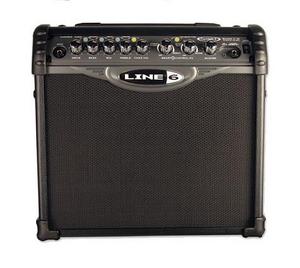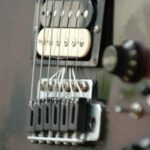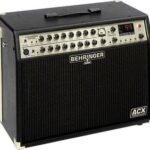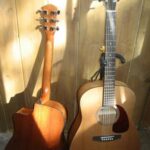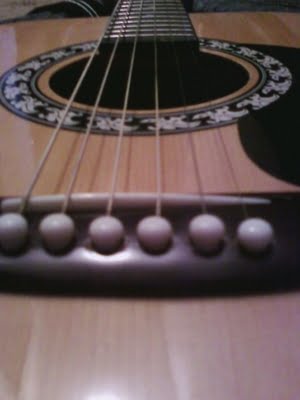Independent local musicians and singers have it rough sometimes. Because we’re not big shot stars [yet], having access to a personal roadie or assistant to help out with technical issues isn’t always an option. As an acoustic guitarist and singer, I have found that some of the most perfect venues to perform in are the small, intimate ones, such as coffeehouses and bookstores. But sometimes, these places are not always equipped with the kind of sound system that is conducive to “soul-stirring performances. This is where the Line-6 Spider electric guitar amplifier comes in.
I purchased the Line-6 Spider amp very shortly after obtaining my first electric guitar. The amp, which costs in the neighborhood of $150 or so, features an 8″ speaker and six different Smart Control Effects. When I wasn’t playing through the amp with my guitar, I realized that it indeed could serve another function: mini-P.A. system.
CONNECTING THE AMPLIFIER FOR VOCAL SOUND
Anyone who’s goofed around with recording has probably stumbled upon this “not-so-secret” secret. The purpose of connecting a microphone to a guitar amp for vocals is two-fold:
1) the amp has enough power and volume to carry sound throughout many small venues.
2) The amp allows the singer to control the sound levels without the need of a sound engineer.
To use the Line-6 as a P.A. System, simply plug your microphone into the “Guitar In” jack of the amp. You will need a mic that is already equipped with a ¼” input plug. But since these types of microphones are virtually impossible to find, you’ll more than likely need to obtain an XLR Female to Stereo (TRS) ¼” Male Mic Cable. This will allow you to connect any microphone directly into the amplifier, as well as any other digital recorders or mixers.
BE YOUR OWN SOUND ENGINEER
The beautiful thing about using this piece of equipment for vocals is that you can create wonderful effects. First and foremost are the four programmable channels: Clean, Crunch, Metal, and Insane. Each particular channel will yield a specific type of sound.
- CLEAN: I have found that this setting is best for the cleanest vocals. Use this setting if you are an acoustic player, or are singing soft ballads, or any type of song where clarity is key.
- CRUNCH: This is a good setting for more experimental vocals. On an electric guitar, you’ll achieve a muffled kind of distortion. A similar effect will be achieved if you use the setting on vocals. I prefer not to use this feature, as the muffled effect has only been desirable for “abstract” sounding background vocals in home studio recording.
- METAL: The “Metal” feature will pretty much yield the same effects as “Crunch” with a slightly harder edge. You’ll want to make sure that if you’re using this feature (or Crunch) that you turn the master volume down extremely low, so as to avoid feedback from the distortion effect.
- INSANE: Ironically, this is one of my favorite effects, as “Insane” sounds exactly like its namesake. Because this is a really “thick” sounding effect, you’ll want to turn the volume down on this one as well. Used with an electric guitar, you can expect the hard-driving gritty sound that is associated with most heavy metal bands. But on vocals a wonderful thing occurs. The effect is muffled, but in this really controlled “telephone booth” type of way. Additionally, the distortion makes it sound as if you’re singing through gravel, which is great if you’re recording rock songs, or are performing live rock music in a small venue.
Another huge asset to using the Line-6 Spider amp is the collection of other effects. There are six different controls: Phaser, Flange, Tremolo, Sweep Echo, Tape Echo, and Reverb.
I have found that each one of these effects (up to two can be used simultaneously) can make your voice sound like it’s coming through the speakers at a huge concert hall. The Tremolo, and both echo settings are great for recording special effects in songs. Phaser and Flange will add a “warbly” kind of effect to your vocals. This can sound strange in some settings. But for experimental music, this can be great. The setting I use most often is reverb; singing through the amp with a hint of reverb is magnificent for live acoustic shows. The mellow flavor of an acoustic guitar coupled with the ethereal sound of reverberating vocals can be really hypnotic!
At any rate, these effects can work wonders in live performances. I would advise against using too many of them, or too much reverb in any one performance, as the effect can be a little overwhelming in small settings. It’s best to regulate the sound according to the size of the room. Gauge the amount of distortion you’ll want depending upon the genre and style of your vocal work.
These sounds can further be fine tuned with the other controls on the Line-6 Spider amp. The bass, mid, and treble functions really help to balance out the distortion effects.
_________________________
Using the Line-6 has been instrumental (no pun intended) in helping me secure gigs around town. In many instances, the smaller venues I’ve played in have had only a moderate sound set up. For finicky singer/musicians such as me, that simply would not do.
It’s an incredibly comforting feeling knowing that your entire sound set-up is controlled and managed by you. I’ve had “trained” sound engineers advise me against using the amp in this way. They’ve stated that the guitar amp was not designed for vocals. But I beg to differ, as do other musicians I’ve worked with. There are many hard, fast rules involved in sound engineering for live performances. But I have found that having a little creativity has helped me out of more than one sound-check travesty.
